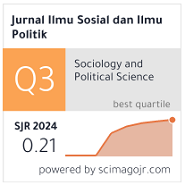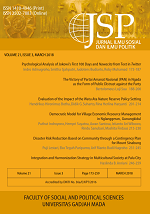Partisanship in Crisis: Public Response to Covid-19 Pandemic in Indonesia
Arya Budi(1*), Warih Aji Pamungkas(2)
(1) Department of Politics and Government, Universitas Gadjah Mada and Department of Political Science, University of Illinois at Urbana-Champaig
(2) Laboratory of Big Data Analytics, Department of Politics and Government, Universitas Gadjah Mada
(*) Corresponding Author
Abstract
Given the fact that in a context of crises, people are concerned with their safety, among other things, partisan response toward policies and public leaders is an intriguing topic. This article examines the extent to which partisanship pertains to the time of the Covid-19 pandemic. We employ natural language processing (NLP) and social network analysis (SNA) on Twitter data to analyse public responses toward prominent political leaders, namely, Indonesian President Joko Widodo (Jokowi) and Jakarta Governor Anies Baswedan (Anies), in handling the crisis of the Covid-19 pandemic in Indonesia. We then put the social media analysis in a framework of political partisanship. Our sentiment analysis through NLP across time and categories found that supports and demands towards the two public figures indicate positive and negative partisanship that replicates previous electoral supports. Similarly, our SNA indicates a high polarization rate among the accounts connected with the two leaders in response to the crisis. Extended analysis of the accounts who are at the epicentres of the sentiment conversations, either positive or negative about Jokowi and Anies, reveals that there are connections with their past political support. Though we find negative partisan responses for both leaders, a type of hard-core partisanship has been leveraged for Jokowi but not for Anies. We conclude that electoral polarization contributes to the extent to which partisanship responses circulate in a context of crisis.
Keywords
Full Text:
PDFReferences
An, J., Quercia, D., & Crowcroft, J. (2014). Partisan sharing: Facebook evidence and societal consequences. Proceedings of the Second Edition of the ACM Conference on Online Social Networks - COSN ’14, 13–24. https://doi.org/10.1145/2660460.2660469
Arifianto, A. R. (2019). What the 2019 Election Says about Indonesian Democracy. Asia Policy, 26(4), 46–53. https://doi. org/10.1353/asp.2019.0045
Aspinall, E., & Mietzner, M. (2019). Southeast Asia’s Troubling Elections: Nondemocratic Pluralism in Indonesia. Journal of Democracy, 30(4), 104–118. https://doi.org/10.1353/jod.2019.0055
Ausserhofer, J., & Maireder, A. (2013). NATIONAL POLITICS ON TWITTER: Structures and topics of a networked public sphere. Information, Communication & Society, 16(3), 291–314. https://doi.org/10.1080/1369118X.2012.756050
Bartels, L. M. (2000). Partisanship and Voting Behavior, 1952-1996. American Journal of Political Science, 44(1), 35. https://doi. org/10.2307/2669291
Boin, A., & Hart, P. ’t. (2003). Public Leadership in Times of Crisis: Mission Impossible? Public Administration Review, 63(5), 544–553. https://doi.org/10.1111/1540-6210.00318
Bullock, J. G. (2009). Partisan Bias and the Bayesian Ideal in the Study of Public Opinion. The Journal of Politics, 71(3), 1109–1124. https://d oi.org/10.1017/ S0022381609090914
Bullock, J., Gerber, A., Hill, S., & Huber, G. (2013). Partisan Bias in Factual Beliefs about Politics (No. w19080; p. w19080). National Bureau of Economic Research. https://doi.org/10.3386/w19080
Burstein, P. (2010). Public Opinion, Public Policy, and Democracy. In K. T. Leicht & J. C. Jenkins (Eds.), Handbook of Politics (pp. 63–79). Springer New York. https:// doi.org/10.1007/978-0-387-68930-2_4
Chen, C., Härdle, W., & Unwin, A. (2008). Handbook of Data Visualization. Springer Berlin Heidelberg. https://doi. org/10.1007/978-3-540-33037-0
Cherven, K., TotalBoox, & TBX. (2015). Mastering Gephi Network Visualization. Packt Publishing. http://www.totalboox. com/book/id-8959988471530263248
Dalton, R. J. (2007). Partisan mobilization, cognitive mobilization and the changing American electorate. Electoral Studies, 26(2), 274–286. https://doi.org/10.1016/j.electstud.2006.04.009
Dalton, R. J. (2014). Citizen politics: Public opinion and political parties in advanced industrial democracies (Sixth edition). SAGE, CQ Press.
Druckman, J. N., Peterson, E., & Slothuus, R. (2013). How Elite Partisan Polarization Affects Public Opinion Formation. American Political Science Review, 107(1), 57–79. https://doi.org/10.1017/ S0003055412000500
Fan, W., & Gordon, M. D. (2014). The power of social media analytics. Communications of the ACM, 57(6), 74–81. https://doi. org/10.1145/2602574
Fisher, J., Fieldhouse, E., Franklin, M. N., Gibson, R., Cantijoch, M., & Wlezien, C. (Eds.). (2017). The Routledge Handbook of Elections, Voting Behaviorand Public Opinion (1st ed.). Routledge. https://doi. org/10.4324/9781315712390
Foster, D. M., & Palmer, G. (2006). Presidents, Public Opinion, and Div ersionary Behavior: The Role of Partisan Support Reconsidered. Foreign Policy Analysis, 2(3), 269–288. https://doi.org/10.1111/j.1743-8594.2006.00030.x
Goren, P. (2005). Party Identification and Core Political Values. American Journal of Political Science, 49(4), 881–896. https:// doi.org/10.1111/j.1540-5907.2005.00161.x
Graham, M. H., & Svolik , M. W. (2020). Democracy in America? Partisanship, Polarization, and the Robustness of Support for Democracy in the United States. American Political Science Review, 114(2), 392–409. https://doi.org/10.1017/S0003055420000052
Gruzd, A., & Mai, P. (2020). Going viral: How a single tweet spawned a COVID-19 conspiracy theory on Twitter. Big Data & Society, 7(2), 205395172093840. https://doi. org/10.1177/2053951720938405
Hanan, D. (2014). Menakar presidensialisme multipartai di Indonesia (Cetakan I). Al- Mizan.
Hanta Yuda A. R. (2010). Presidensialisme setengah hati: Dari dilema ke kompromi. Gramedia Pustaka Utama.
Harvey, K. (2014). Encyclopedia of Social Media and Politics. SAGE Publications, Inc. https://doi.org/10.4135/9781452244723
Hosseini, P., Hosseini, P., & Broniatowski, D. A. (2020). Content analysis of Persian/ Farsi Tweets during COVID-19 pandemic in Iran using NLP. ArXiv:2005.08400 [Cs]. http://arxiv.org/abs/2005.08400
Jacobson, S., Myung, E., & Johnson, S. L. (2016). Open media or echo chamber: The use of links in audience discussions on the Facebook Pages of partisan news organizations. Information, Communication & Society, 19(7), 875–891. https://doi.org/10.1080/1369118X.2015.1064461
Jeffares, S. (2014). Interpreting Hashtag Politics. Palgrave Macmillan UK. https://doi. org/10.1057/9781137357748
Kietzmann, J. H., Hermkens, K., McCarthy, I. P., & Silvestre, B. S. (2011). Social media? Get serious! Understanding the functional building blocks of social media. Business Horizons, 54(3), 241–251. https://doi. org/10.1016/j.bushor.2011.01.005
Kwon, K. H., Bang, C. C., Egnoto, M., & Raghav Rao, H. (2016). Social media rumors as improvised public opinion: Semantic network analyses of twitter discourses during Korean saber rattling 2013. Asian Journal of Communication, 26(3), 201–222. https://doi.org/10.1080/01292986.2015.1130157
Lee, P. S. N., So, C. Y. K., Lee, F., Leung, L., & Chan, M. (2018). Social media and political partisanship – A subaltern public sphere’s role in democracy. Telematics and Informatics, 35(7), 1949–1957. https://doi. org/10.1016/j.tele.2018.06.007
Levendusky, M. (2009). The Partisan Sort: How Liberals Became Democrats and Conservatives Became Republicans . Univ ersity of Chicago Press. https://doi.org/10.7208/ chicago/9780226473673.001.0001
Liddle, R. W., & Mujani, S. (2007). Leadership, Party, and Religion: Explaining Voting Behaviorin Indonesia. Comparative Political Studies, 40(7), 832–857. https:// doi.org/10.1177/0010414006292113
Lupu, N. (2014). Brand Dilution and the Breakdown of Political Parties in Latin America. World Politics, 66(4), 561–602. https:/ / doi.org/10.1017/ S0043887114000197
Matthes, J., Davis, C. S., & Potter, R. F. (Eds.). (2017). The International Encyclopedia of Communication Research Methods (1st ed.). Wiley. https://doi. org/10.1002/9781118901731
Mietzner, M. (2020). Authoritarian innovations in Indonesia: Electoral narrowing, identity politics and executive illiberalism. Democratization, 27(6), 1021–1036. https:// doi.org/10.1080/13510347.2019.1704266
Mietzner, M., & Associate Professor, Coral Bell School of Asia Pacific Affairs, College of Asia and the Pacific, Australian National University, Canberra; and Visiting Research Scholar, Center for Southeast Asian Studies, Kyoto University, Kyoto. (2016). Coercing Loyalty: Coalitional Presidentialism and Party Politics in Jokowi’s Indonesia. Contemporary Southeast Asia, 38(2), 209–232. https://doi. org/10.1355/cs38-2b
Mietzner, M., Muhtadi, B., & Halida, R. (2018). Entrepreneurs of Grievance: Drivers and Effects of Indonesia’s Islamist Mobilization. Bijdragen Tot de Taal-, Land- En Volkenkunde / Journal of the Humanities and Social Sciences of Southeast Asia, 174(2–3), 159–187. https:// doi.org/10.1163/22134379-17402026
Mujani, S., Liddle, R. W., & Ambardi, K. (2018). Voting Behavior in Indonesia since Democratization: Critical Democrats (1st ed.). Cambridge University Press. https:// doi.org/10.1017/9781108377836
Müller, A. C., & Guido, S. (2016). Introduction to machine learning with Python: A guide for data scientists (First edition). O’Reilly Media, Inc.
Norris, P. (1999). Critical Citizens. Oxford Univ ersity Press. https://doi. org/10.1093/0198295685.001.0001
Odegard, P. H. (1960). The American Voter. Angus Campbell, Philip E. Converse, Warren E. Miller, and Donald E. Stokes. Wiley, New York, 1960. 573 pp. $8.50. Science, 132(3420), 138–140. https://doi. org/10.1126/science.132.3420.138
Page, B. I., & Shapiro, R. Y. (1983). Effects of Public Opinion on Policy. American Political Science Review, 77(1), 175–190. https://doi.org/10.2307/1956018
Parahita, G. D. (2019). Voters (Dis)-Believing Digital Politic al Dis info rm atio n in Gubernatorial Election of DKI Jakarta 2016-2017. Jurnal Ilmu Sosial Dan Ilmu Politik, 22(2), 127. https://doi.org/10.22146/ jsp.33736
Pătruţ, B., & Pătruţ, M. (Eds.). (2014). Social Media in Politics: Case Studies on the Political Power of Social Media (Vol. 13). Springer International Publishing. https://doi. org/10.1007/978-3-319-04666-2
Penney, J. (2017). The Citizen Marketer (Vol. 1). Oxford University Press. https://doi.org/10.1093/acprof :o so/9780190658052.001.0001
Polarisation in Indonesia: What if perception is reality? (2019, April 16). New Mandala. https://www.newmandala.org/how- polarised-is-indonesia/
Reid, M. M., Jarrett Renshaw, Tim. (2020, April 22). How Trump allies have organized and promoted anti-lockdown protests. Reuters. https://www.reuters.com/article/ us-health-coronavirus-trump-protests- idUSKCN2233ES
Samuels, D. J., & Zucco, C. (2018). Partisans, Antipartisans, and Nonpartisans: Voting Behavior in Brazil (1st ed.). Cambridge University Press. https://doi.org/10.1017/9781108553742
Setiawan, R. (n.d.). Anies akan Surati Menkes Terawan Minta Jakarta Segera Tetapkan PSBB. tirto.id. Retrieved November 8, 2020, from https://tirto.id/anies-akan- surati-menkes-terawan-minta-jakarta- segera-tetapkan-psbb-eKqG
Small, T. A. (2011). WHAT THE HASHTAG?: A content analysis of Canadian politics on Twitter. Information, Communication & Society, 14(6), 872–895. https://doi.org/10.1080/1369118X.2011.554572
Soroka, S. N., & Wlezien, C. (2005). Opinion– Policy Dynamics: Public Preferences and Public Expenditure in the United Kingdom. British Journal of Political Science, 35(4), 665–689. https://doi.org/10.1017/ S0007123405000347
Thomassen, J. (2005). The European Voter. Oxford University Press. https://doi. org/10.1093/0199273219.001.0001
Trottier, D., & Fuchs, C. (Eds.). (2014). Social media, politics and the state: Protests, revolutions, riots, crime and policing in the age of Facebook, Twitter and YouTube. Routledge.
Van Bavel, J. J., & Pereira, A. (2018). The Partisan Brain: An Identity-Based Model of Political Belief. Trends in Cognitive Sciences, 22(3), 213–224. https://doi. org/10.1016/j.tics.2018.01.004
Wlezien, C. (2004). Patterns of Representation: Dynamics of Public Preferences and Policy. The Journal of Politics, 66(1), 1–24. https:// doi.org/10.1046/j.1468-2508.2004.00139.x
Article Metrics
Refbacks
- There are currently no refbacks.
Copyright (c) 2021 Jurnal Ilmu Sosial dan Ilmu Politik

This work is licensed under a Creative Commons Attribution-NonCommercial-NoDerivatives 4.0 International License.






















